Day Walk of Ryogoku: Sumo, Swords, Souvenirs, and Wild Boar
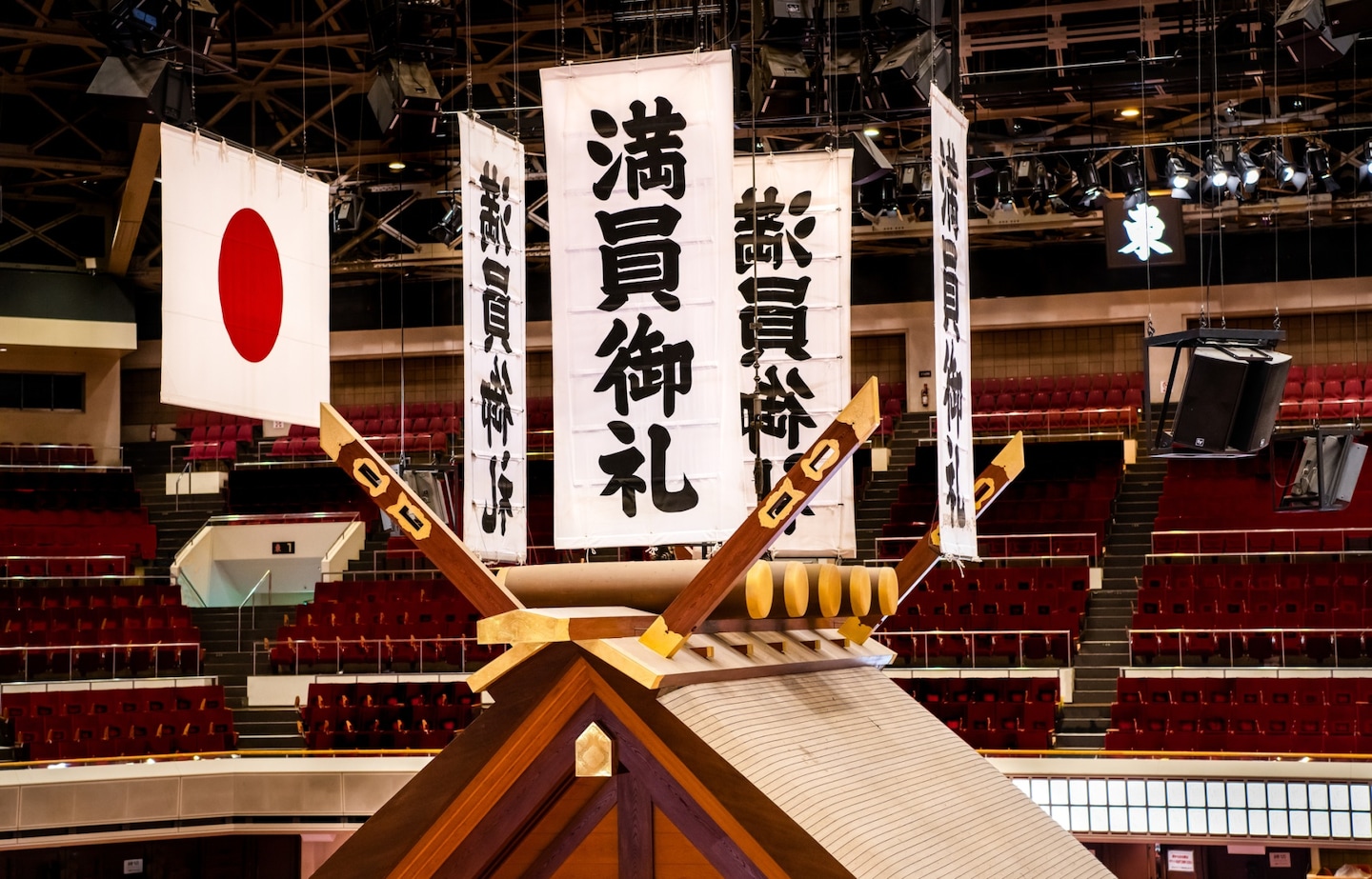
Above: The ceremonial roof of the Kokugikan Arena
Tokyo's Ryogoku district is closely associated with sumo, but there's plenty more to see and do here in this traditional area of downtown Tokyo. Mark Schreiber leads a route to the Sumo Museum, Sword Museum, Hokusai Museum and some unusual dining experiences.
In olden times the Sumida river formed the boundary between two feudal domains, Musashi and Shimousa, and the area came to be named Ryogoku, meaning "two countries." Following completion of the first bridge spanning the Sumida river, Ryogoku-bashi, in 1659, the area flourished as a commercial and amusement area.
Ryogoku is closely associated with the sport of professional sumo. From pre-modern times rikishi (wrestlers) trained and lived in sumo beya, or stables as they are commonly referred to in English. At present out of a total of 45 stables, about 13 are located proximate to Ryogoku, with businesses to feed and clothe them that have sprung up over the years.
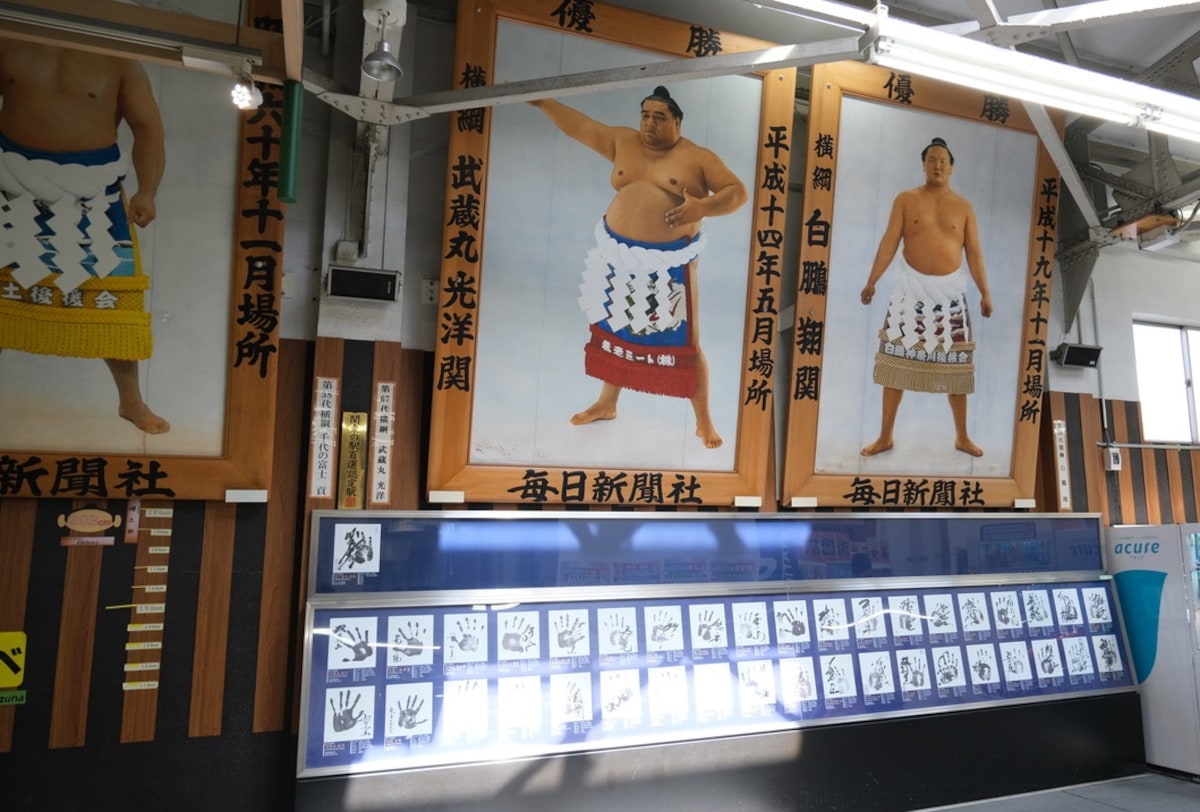
Our walk begins at the west exit of Ryogoku Station on the JR Sobu Line. The exit area is festooned with sumo-related motifs, including two life-size portraits of previous tournament winners and banners suspended from the ceiling that read Man'in Onrei ("full house," announced when the venue is sold out).
An immediate right upon leaving the station takes you to a new building named Edo Noren, which houses the Ryogoku Information Center, dispensing free English-language maps, brochures and other visitor information. There are also about a dozen concessions ranging from a 7-Eleven convenience store to a bakery, seven restaurants and a bar, somehow appropriately named Liquor Museum.

Edo Noren's ground floor also boasts a full-size dohyo (sumo ring), a perfect facsimile of the ring in which sumo bouts are held. (Take all the photos you want, but please refrain from stepping inside.)
The Kokugikan National Sumo Arena: Tournament Venue and Museum
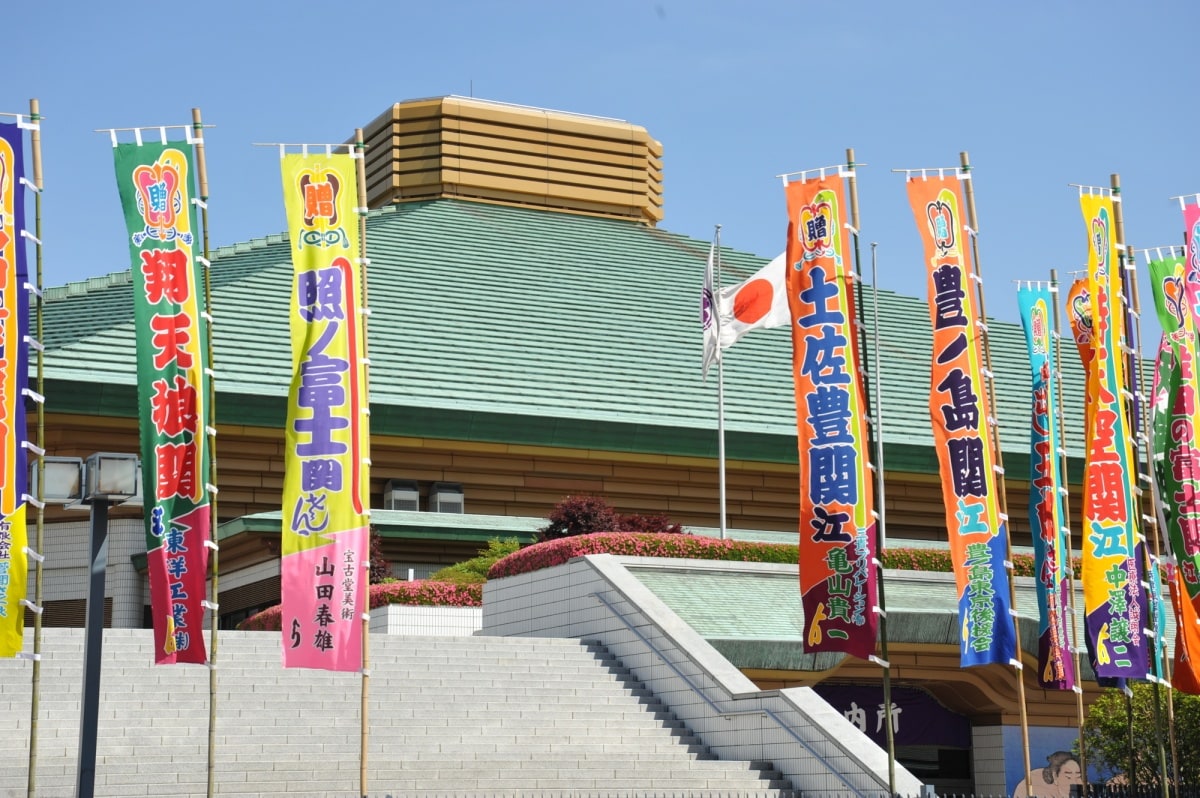
The traditional influenced roof of the Kokugikan National Sumo Arena, iconic home to Tokyo's sumo tournaments
Sumo matches were originally performed out-of-doors on the grounds of Buddhist temples. The original Kokugikan arena was completed in 1909, and was scheduled to be the venue for boxing and Graeco-Roman wrestling in the 1940 Olympics (which were cancelled due to WW2). During the postwar period that building was taken over by U.S. forces and then purchased by Nihon University, while sumo tournaments were held at a different venue in nearby Kuramae. The new Kokugikan, with a capacity of 11,098, opened in 1985.
Located immediately north of JR Ryogoku station, the Kokugikan hosts three of the six annual grand sumo tournaments—lasting 15 days each in January, May and September. On the days when tournaments are being held, you'll need a sumo admission ticket to enter. On other days, you'll have to satisfy your sumo needs at the small museum inside.
The museum is small, admission is free, and a visit shouldn't require longer than 10 to 15 minutes. On display are various items that will be immediately recognizable to dyed-in-the-wool sumo fans, such as antique kessho mawashi, the colorful embroidered aprons worn by top-ranked grapplers during ceremonial activities.
Japan Sumo Associate Website
Tournament schedules, ticket information, etc.
Sumo Museum Website
Open from 10:30 a.m. to 4:00 p.m.
Former Yasuda Garden
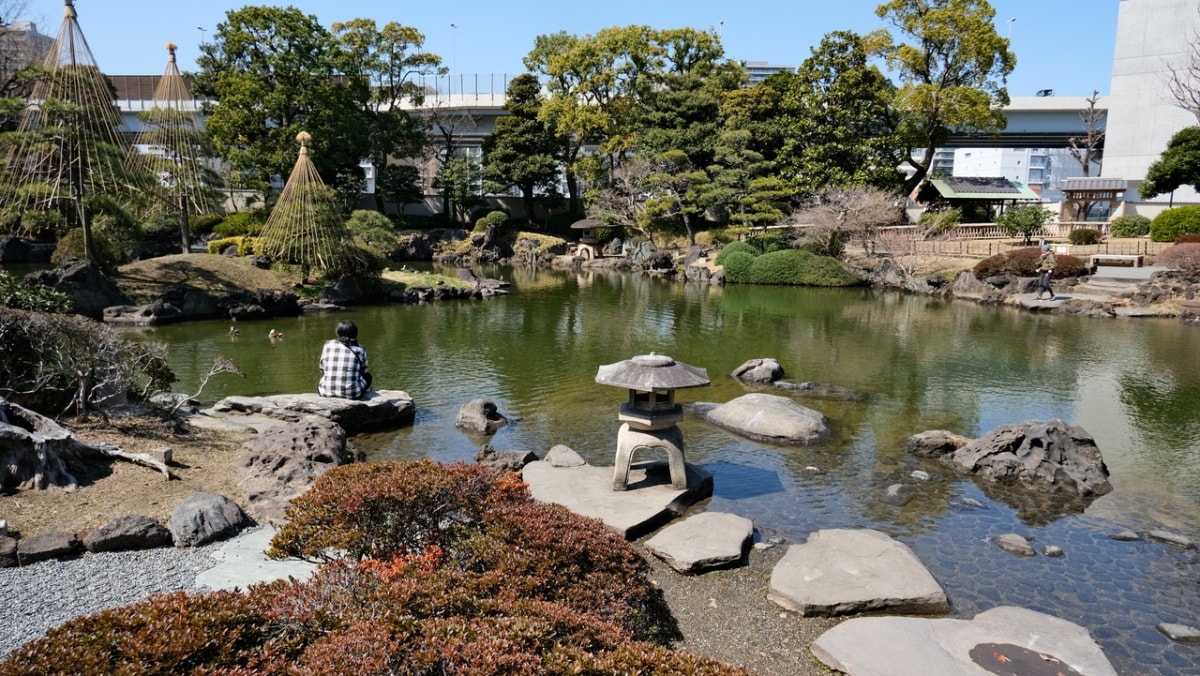
The urban oasis of the Former Yasuda Garden.
After leaving the Kokugikan, keep walking along the tree-lined street for two or three minutes and you'll come to a small gate that serves as an entry to the Kyu-Yasuda Garden. The original garden dates back to the residence of a powerful samurai clan built in the Genroku Era (1688-1703). Its pond was sculpted in the shape of the ideograph for heart, (心), and draws its water from the nearby Sumida river. In 1891 the property was purchased by Zenjiro Yasuda (1838-1921), a wealthy banker and philanthropist—and the maternal great-grandfather of artist and musician Yoko Ono. Yasuda bequeathed the garden to the city following his death in 1921. It opened to the public in 1927.
The garden is open every day except during the New Year holiday, from 9:00 to 19:00, closing at 18:00 in winter. Restrooms are available in the Shinji-tei rest house on the garden's north side. Admission is free.
Former Yasuda Garden website
The Japanese Sword Museum
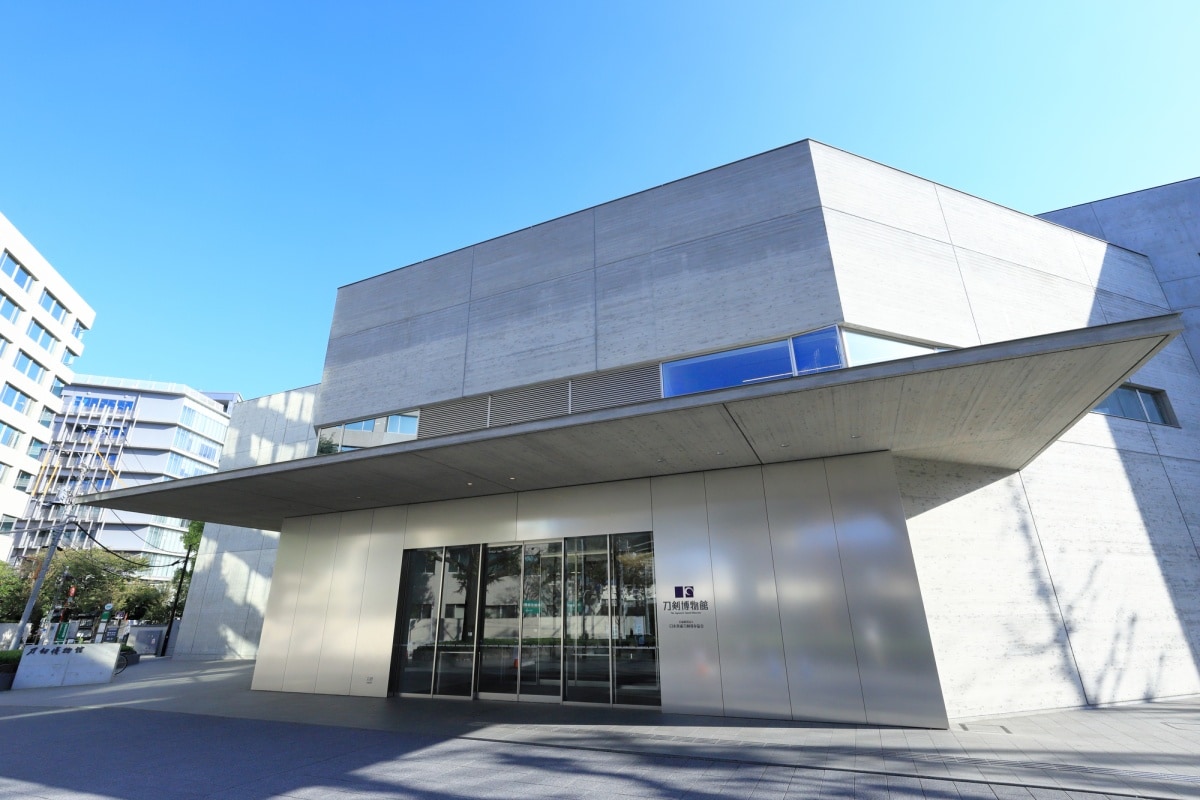
The exterior of the Japanese Sword Museum reflects the metallic luster and sharp angles of Japanese swords.
Immediately adjacent to the Yasuda Garden's exit on the north side is the Japanese Sword Museum (Token Hakubutsukan). Upon paying the ¥1,500 admission, visitors can see famous works of sword craftsmen, along with other accouterments of the samurai warrior culture. Except for genuine antiques and modern works of art, like the ones displayed in this museum, ownership of swords is subject to tight controls similar to firearms, and prohibited without a special permit.
Japanese Sword Museum website
Sword Museum hours: 9:30 to 17:00. Closed Mondays, at times when exhibits are changed and during the New Year holidays. Telephone: 03-6284-1000.
Honoring an Icon: The Sumida Hokusai Museum

As this life-size wax figure shows, even in his dotage, Hokusai continued to practice his art.
Walking east for 5 minutes from the east exit of JR Ryogoku station, you'll come to Hokusai Dori. Just behind a playground is an ultra-modern building that houses the Sumida Hokusai Museum
A native of Edo, Katsushika Hokusai (1760-1849) was the son of an artisan who made mirrors for the Shogun. The boy demonstrated artistic skills from a young age, and used dozens of pseudonyms during his long career, of which Hokusai—written with characters that mean "northern studio"—is the best known in both Japan and the west.
Although most famous for his illustrated woodblock prints, Hokusai was prolific, the master of many genres, including "Hokusai manga," which means whimsical or impromptu sketches.
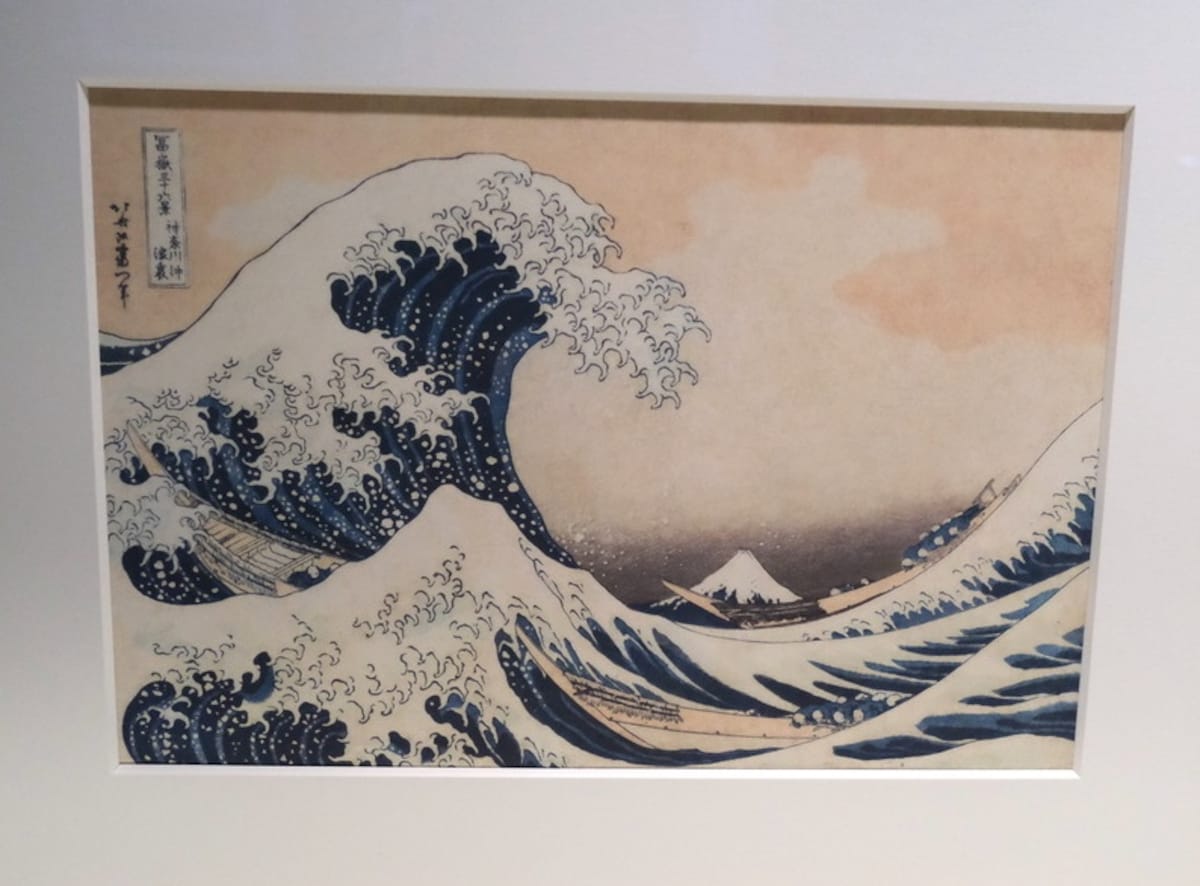
An original print of Hokusai's famous great wave, with Mt. Fuji in the background
Hokusai did not live to see the opening of Japan to the west, but foreign traders and others who settled in Yokohama recognized his talents. During the wave of Japonisme that spread across Europe in the late 19th century, his works are thought to have had a significant influence on such artists as Vincent van Gogh and Claude Monet.
The Great Wave off Kanagawa, which was sketched around 1831 as one of a series titled "Thirty-six Views of Mount Fuji," has been described as "possibly the most reproduced image in the history of all art," as well as being a contender for the "most famous artwork in Japanese history."
After viewing the 4th floor displays, be sure to save time to check out the museum shop on the ground floor, which is full of books and other Hokusai-related merchandise.
Sumida Hokusai Museum website
Hours: Tuesday-Sunday 9:30 am – 5:30 pm. Admission: ¥400 adults/¥300 for university/high-school students and seniors over age 65.
A BIG men's store

From the rear of the Hokusai Museum, if you walk beneath the Sobu line train tracks and turn right on the Keiyo Doro, on a corner about six or seven minutes on foot from the Sumida Hokusai Museum, you'll spot Lion-do, a local landmark that has been keeping sumo wrestlers and other large men clothed for generations. Most of its merchandise is made in Japan and the quality is very good.
If you need to buy a unique souvenir for a large man, consider one or two pairs of boxer briefs with sumo patterns, in a variety of colors, or perhaps an extra-large men's T-shirt. The shop also carries suteteko (white cotton undergarments worn under kimono) in waist sizes up to 165cm (65 inches), and jimbei, a lightweight leisure ensemble worn during the hot months.
Lion-do website
Open from 9:30 a.m. to 6:30 p.m. daily except Sundays and public holidays. (Telephone 3631-0650.)
On the other side of the Keiyo Doro from Lion-do, Ryogoku Takahashi sells an extensive assortment of colorful sumo-related merchandise, including bedding, towels, door curtains, stationery, accessories and toys.
Ryogoku Takahashi website
Open from 9:30 a.m. to 6:30 p.m. daily except Sundays and public holidays. (Telephone 3631-0650)
Chanko sumo-style stew
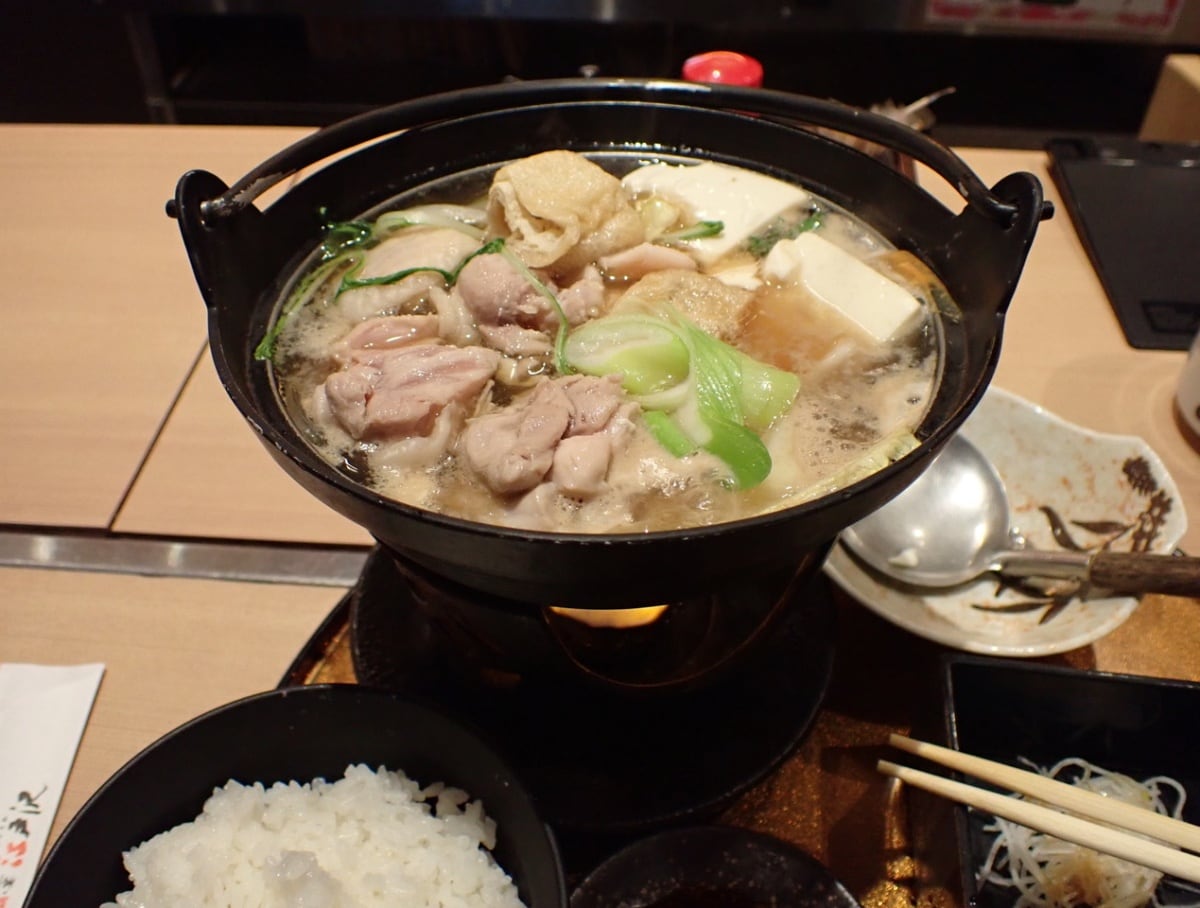
By this time you may be ready for lunch, and being in Ryogoku, it might make sense to sample chanko nabe. Translated as "sumo wrestlers' hot pot" or "wrestlers' stew." this is what wrestlers consume in large quantities after their morning practice.
The best way to try chanko nabe would be to take an actual meal as a guest at a sumo stable, which would require careful planning and personal connections. Most visitors, however, must settle for one of the dozen or so chanko restaurants in the Ryogoku area.
Try the chanko teishoku (set lunch) at Chanko Edosawa Bekkan, located on the street running along the south side of the JR Sobu line tracks, about midway between JR Ryogoku station's west and east exits. For a very reasonable outlay of just ¥1,280 you'll get a satisfying set meal that includes a sashimi appetizer, rice, and a chicken- and tofu-based chanko stew cooked at the table.
Chanko Edosawa Bekkan website
3-26-4 Ryogoku, Sumida-ku
Phone: 03-5600-3211
A Buddhist Temple and Japan's "Robin Hood"
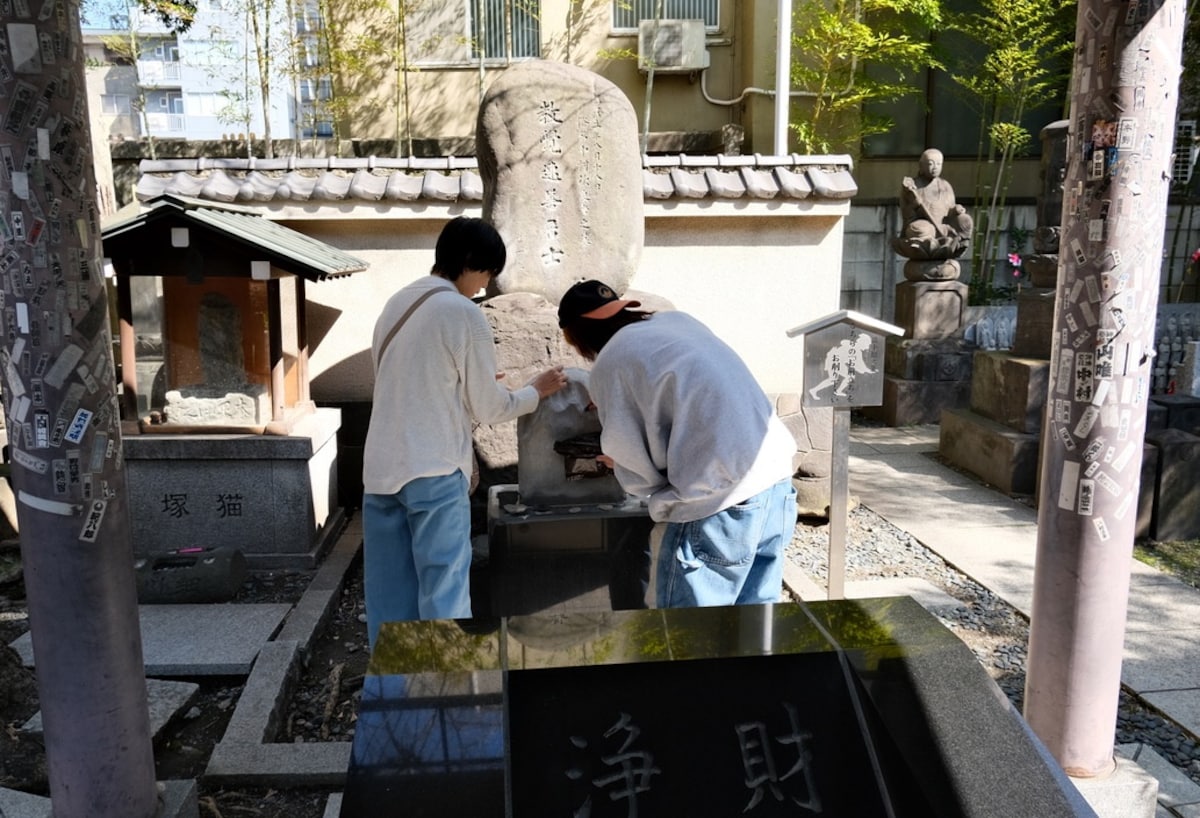
Two visitors to the grave of Japan's "Robin Hood" follow the tradition of chipping away at his grave marker.
After lunch, stroll back to the Keiyo Doro to the Ekoin, a Buddhist temple associated with many events in Tokyo's long history. Some visitors go to offer prayers for family members and others for their departed pets (there are monuments to both dogs and cats). Or drop in on the grave of a man who enjoyed a 15-year career as perhaps Japan's most brazen thief.
Known as Nezumi Kozo, his real name was Jirokichi. At the time of his arrest in 1832, he had plundered the coffers of at least 76 samurai estates. He was sentenced to death, and on the 19th day of the eighth month of 1832, he was led around the town on horseback, on the way to his execution by decapitation.
In the years after Nezumi Kozo's execution, his exploits soon became something of a legend. Edo’s common folk had no great love of their samurai overlords and among the posthumous embellishments to his story was that he magnanimously shared his booty with the poor, in the manner of Robin Hood. (Actually the funds he looted made it possible for him to marry several times, as well as support several mistresses.) But most of his booty went to gambling, an activity to which he was hopelessly addicted.
When visiting his grave, it became a custom to chip off a fragment of the grave marker to bring good luck at gambling. Rather than discourage this practice, Eko'in even leaves out stones for visitors to chip away at the grave marker, and if you feel so inclined, you're welcome to indulge.
Ekoin website
2-8-10 Ryogoku, Sumida-ku
Pigging Out on Wild Boar
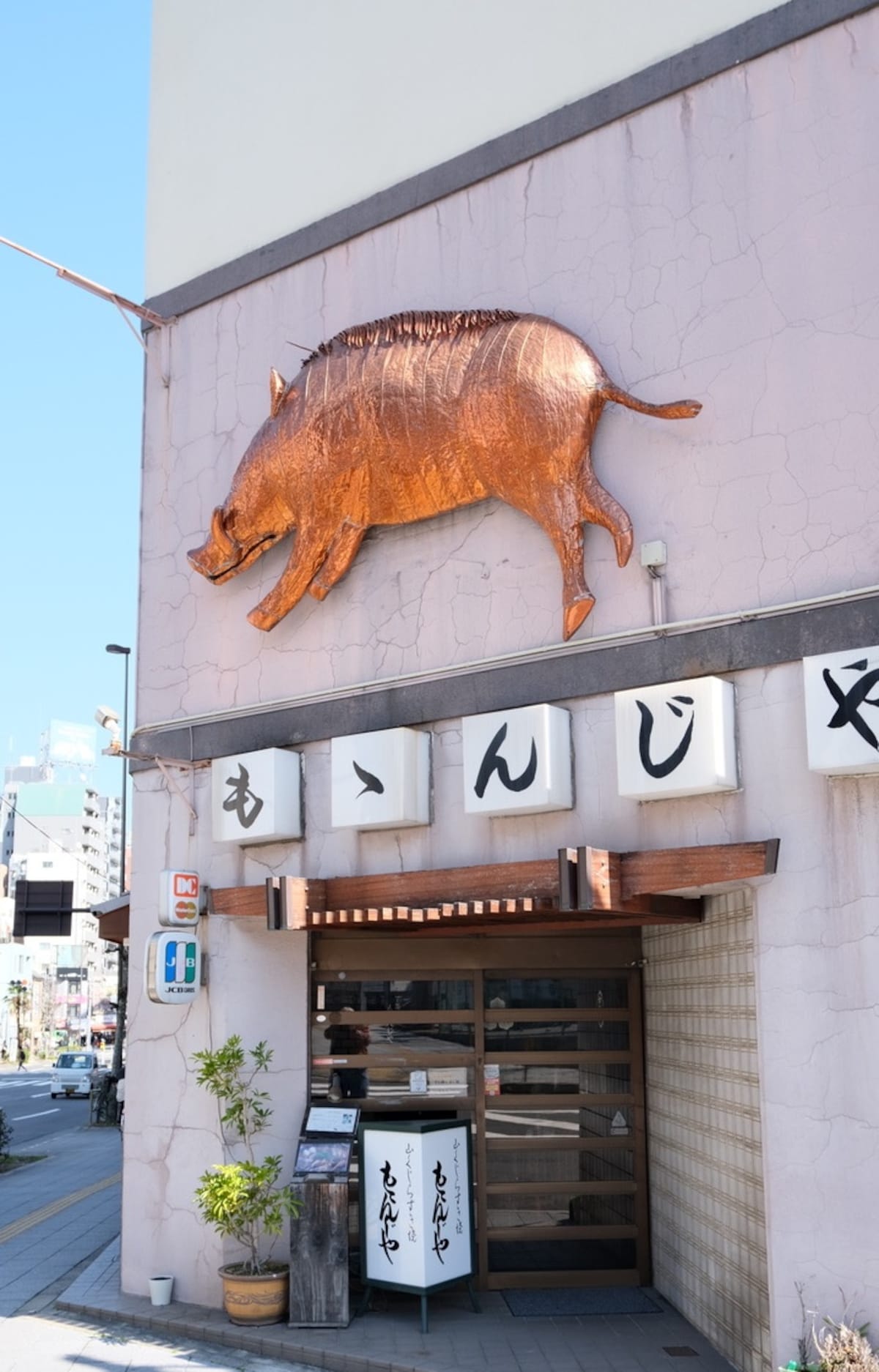
Leaving Ekoin and turning left, you'll soon see the Sumida river and Ryogoku-bashi bridge. On the corner is the Momonja restaurant, a landmark in business since 1718. Its specialties are wild boar and other wild game, served in a relaxed atmosphere in private or semi-private tatami rooms by kimonoed waitresses.
Set courses include a choice of boar, venison and bear (¥7,480) or boar meat only (¥6,600). Beverages are not included, so you can expect a meal with drinks to run between ¥8,000 and ¥10,000 per person. Dedicated gourmands will find it worth the experience.
Momonja website
One for The Road: Craft Beer at Beer Club Popeye
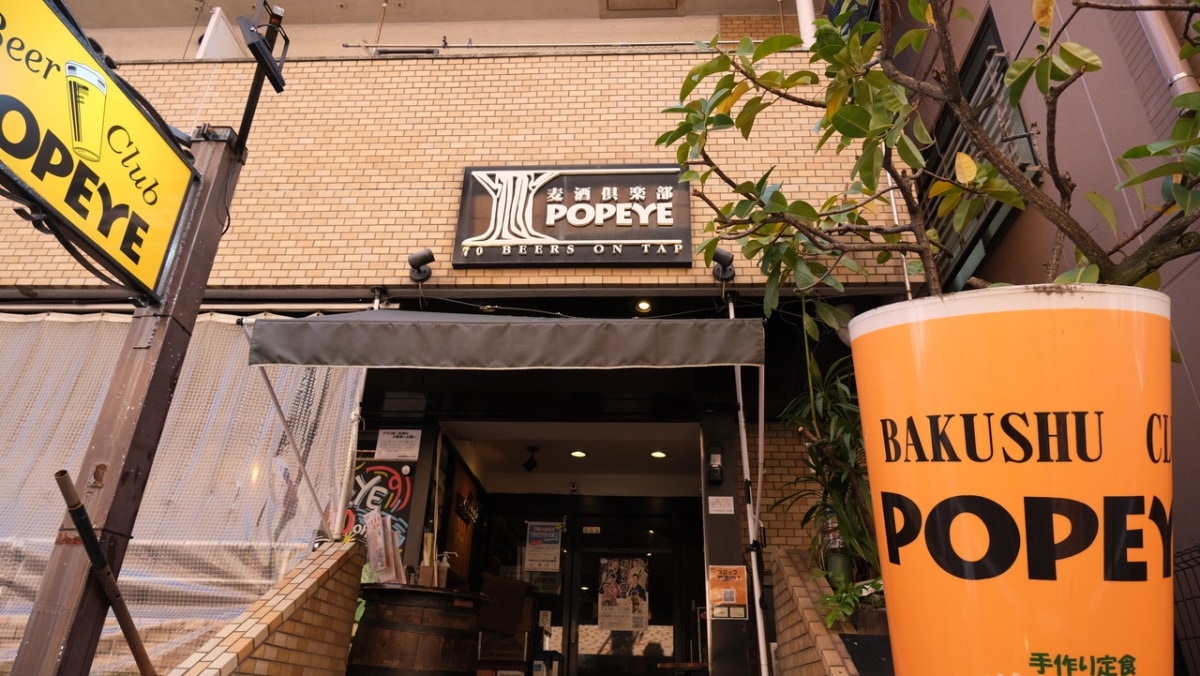
Two side streets south from JR Ryogoku station's west exit is Beer Club Popeye, a popular craft beer pub that boasts 70 varieties of domestic and foreign labels. Popeye fills up quickly in the evenings, so it's best to phone for a reservation. Open from 15:00 to 23:30 on weekdays, and from 14:00 to 23:30 on Saturdays and public holidays. Closed Sundays.
Beer Club Popeye website
Revenge Took Place Here: Remnants of a Legendary Vendetta

Remember the saga of the 47 Ronin? The famous samurai vendetta climaxed in Ryogoku, and you can also drop in on Honjo Matsuzaka-cho Koen, a tiny park that is all that remains of a sprawling estate where, on January 30, 1703, the famous 47 masterless samurai from Ako in Hyogo Prefecture extracted revenge against Lord Kira Kozuke-no-Suke Yoshihisa, who they blamed for the death of their master. The park is surrounded by a distinctive low white wall capped with gray roofing tiles. Inside are signboards explaining the history, a Shinto altar and a sculpture of Lord Kira.
Address: 3-13-9 Ryogoku, Sumida-ku
You can read the whole story here



